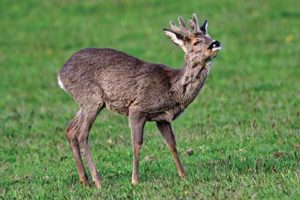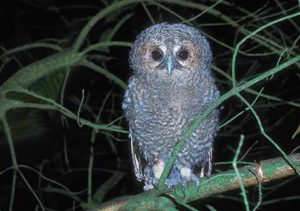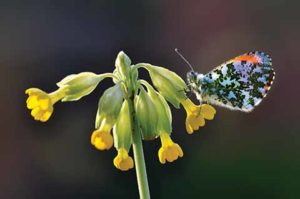April in Dorset
Colin Varndell looks at a special month for the county’s wildlife
Published in April ’18
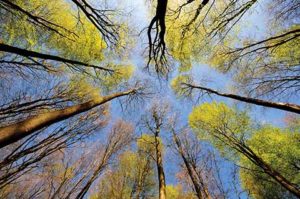
Deciduous trees burst into leaf throughout April, but the canopy is not complete until mid-May, by which time the early woodland flowers will have set seed
In April, the surge of the promise of new life is evident everywhere in the Dorset countryside. There is an atmosphere of intense activity and the sights, sounds and smells of the month characterise mammals, reptiles, birds, plants and invertebrates renewing their annual rhythms of life.
While this fervour for life can be seen throughout the land, the range of different habitat types in Dorset supports a greater variety of wildlife to watch and enjoy than in many
other counties.
April is the time for a succession of wild blossoms to unfold in the countryside, beginning with blackthorn and wild cherry blossom and ending with the creamy-white flowers of hawthorn. Blackthorn can blossom over quite a long period, especially during mild springs, when it can be in bloom from March through to late April. The old country sayings about blackthorn winters (cold snaps when the blackthorn flowers) are born out of coincidence, as this understorey shrub does not induce low temperatures, but blossoms at a time when cold weather can still occur.
The colour of the Dorset countryside is tinted with yellow at the beginning of the month as roadside banks display drifts of primrose, lesser celandine and wild daffodil. Pasture fields are tinted with bright daubs of dandelion flowers, and on unimproved grassland, cowslips bloom, mingling with dandelion clocks and early orchids. It is at this time when willow trees display their silvery buds, bursting into golden catkins, heavy with pollen, in hedges and copses.
The first fresh butterflies to emerge are seen on warm April days, flitting along country lanes. They include the green-veined white, holly blue and orange tip. The latter will only be on the wing throughout early spring as it produces only one generation a year. The brimstone, with its erratic flight, appears like a blur of sulphur yellow as it dances along the hedgerows. Unlike the other spring butterflies, the brimstone is not freshly hatched, but started life as an adult butterfly last August. Its unusual wing shapes helped it to merge into evergreen foliage for the winter.
Birdsong in our gardens and the countryside generally peaks this month as summer migrants from the south join resident species. This annual spectacular phenomenon of sound occurs as males deliver their songs to establish and maintain breeding territories and also to impress potential mates. The incomers from the south are motivated by lengthening hours of daylight, allowing them maximum time to spend on bringing up their chicks. The first to arrive are the chiffchaff and willow warbler. Sadly, the latter is in decline as it spends the winter south of the Sahara desert. The desert continues to expand due to climate change, and it is increasingly difficult for these tiny birds to survive the crossing of such a hostile landscape.
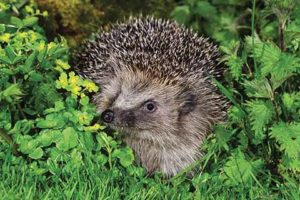
Hedgehogs which have survived the rigours of hibernation will emerge this month. These nocturnal animals are especially hungry now, as during hibernation an individual will have lost one-third of its body weight.
As birdsong fades with the rising dusk, other sounds begin to echo across fields and woods as nocturnal wildlife take centre stage. Badger cubs, born in February, can now be heard squealing and yelping as they explore their home range above ground with their mothers. The persistent, hissing calls of tawny owl fledglings resonate in woods and copses this month. Young tawny owlets leave the safety of their nest holes before their flight feathers are fully developed. It is thought that such noisy chicks might attract predators and therefore are safer scattered around in the bushes than left in a tree cavity nest together. They can sometimes be found at this time of year in daylight, sitting on low branches or even on the ground. Tawny owlets should be given a wide berth, as this is a natural stage in their development, and besides, adult tawny owls will defend their young vigorously, even against humans!
The relatively coolness of the month makes April a good time for reptile watching. Snakes and lizards will be spending more time basking now than they will later in the summer. Also, reptiles are coming into their breeding condition and will show off much brighter colours and markings towards the end of this month than at any other time of year.
The wild flowers, which bring so much vibrant colour to woods, hedgerows and country lanes this month are no happy accident of nature. The spring flowers have evolved as woodland species, and therefore have developed short, early flowering seasons to coincide with maximum availability of sunlight under trees. By the time the foliage of deciduous trees opens and the dark shadow of the canopy is cast across the woodland floor, these plants will have successfully set seed. The colour of April ends with blue as a growing tide of nodding bluebells engulfs copses and woodlands across Dorset.
